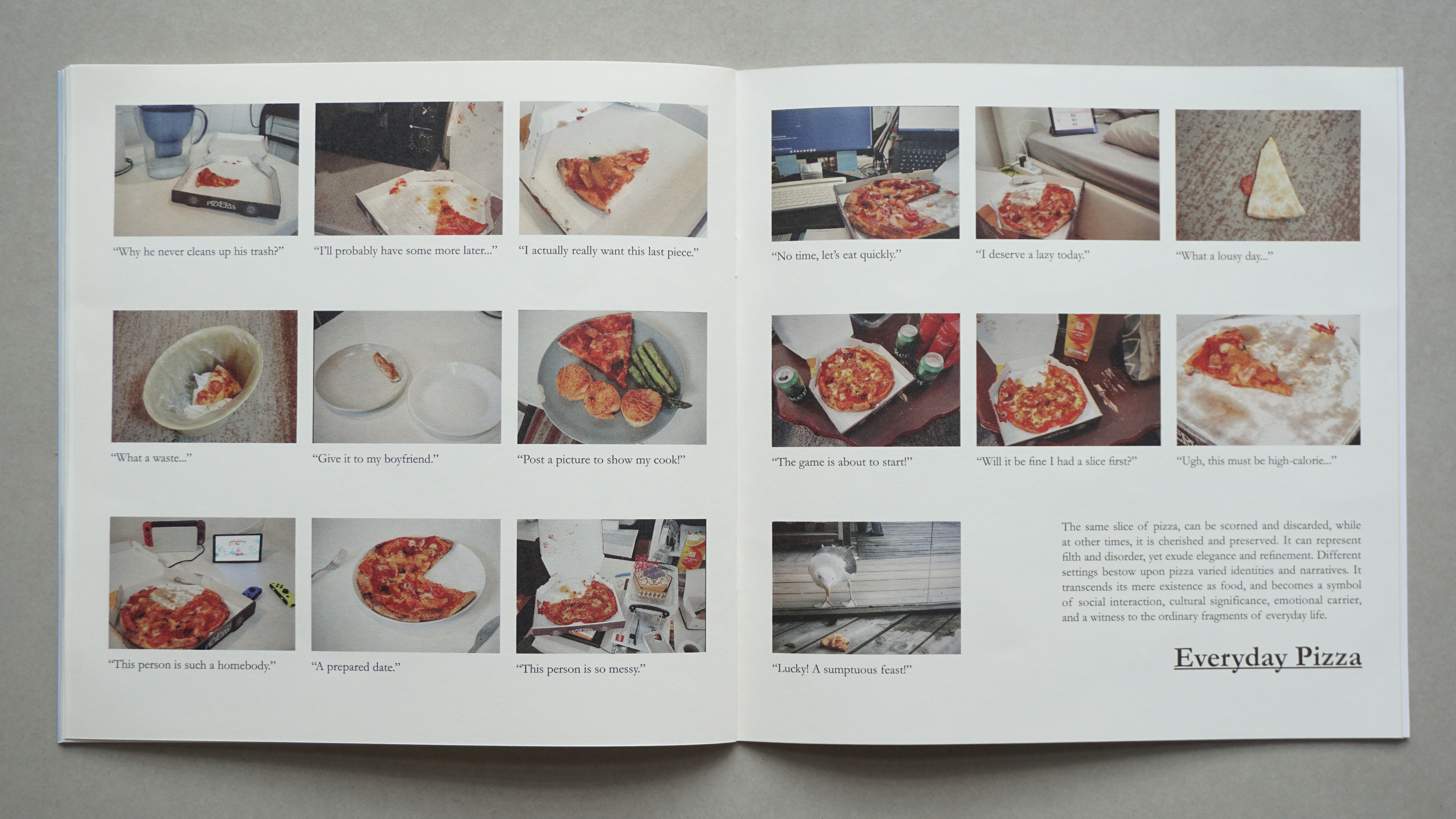The Pizza Book: Sensation of the ordinary
I met an Italian friend
this summer in 2023
. At one point, I said, “At least I know one Italian word, pizza.” However, she replied, “No, but ‘pizza’ is an international word.”
This interaction sparked my interest, leading us to engage in further discussions about pizza. I realized that even for such a globally recognized food, my understanding of it was deeply rooted in my Chinese cultural ecosystem, whether it was the way I consumed it or the underlying thought processes behind my actions. My reflections and design ideas based on the conversations and my observations were documented in “The Pizza Book”.
This interaction sparked my interest, leading us to engage in further discussions about pizza. I realized that even for such a globally recognized food, my understanding of it was deeply rooted in my Chinese cultural ecosystem, whether it was the way I consumed it or the underlying thought processes behind my actions. My reflections and design ideas based on the conversations and my observations were documented in “The Pizza Book”.
This process of reinterpreting everyday things brought me a sense of relaxation. Amidst the stress of rapid and overwhelming information, the original connotations of everyday matters are largely flattened. In The Pizza Book, ‘pizza’ was focused as a central theme to conduct information filtering and presentation. Various daily scenes related to pizza were gathered, aiming to broaden perspectives through the collision of Chinese and Italian cultures. After this, 'pizza' is no longer just a food, but a way, a mood, a character and a symbol.
The ‘Sandard’ Way
Slow down, rediscovering the original intention

In 2005, pizza was the eagerly anticipated delight that had children eagerly waiting all week long.

In 2023, pizza has become an essential companion in times of urgency.
The taste of pizza remains unchanged; it is the people who have shifted their focus,
the relentless acceleration of life’s rhythm, and an increasing insatiable sense of satisfaction.
Pizza is the original intention left behind by modern life.
![]()
the relentless acceleration of life’s rhythm, and an increasing insatiable sense of satisfaction.
Pizza is the original intention left behind by modern life.

Behind ‘Equal’
As the pages of the book unfold, the crease divides the pizza into seemingly equal halves.
But does equal area necessarily imply fair distribution?
What about dividing the pizza based on an equal portion of meat for each person?
But does equal area necessarily imply fair distribution?
What about dividing the pizza based on an equal portion of meat for each person?
When a group of Chinese friends share a pizza, they always hope for an even distribution. It is natural and accepted tooffer the larger piece to others when faced with two differently sized pizzas. Then the two individuals may engage in a polite exchange, potentially leading to complications or the need for concessions. “I can’t eat anymore,” they would say, although it’s not always the case that one is perfectly satisfied.
The dividing plate, much like an ancient Chinese sundial, accurately marks each moment in time. The divisions
are designed to be most prominent at the number ‘12.’ Here, ‘12’ is the perfect number, allowing for precise and fair distribution among 1, 2, 3, 4, and 6 individuals——a
splitting method applicable to most cases involving fewer than 10 people. The dividing plate also provides reference
lines for perfect divisions among 5, 8, and 9 individuals. But if you have 7 people, it is advisable not to share a single pizza, as fairness will forever remain elusive in such a scenario.
Confucian philosophy emphasizes the concept of “courtesy” in interpersonal relationships, promoting respect, humility, and selflessness. On the other hand, Confucian culture also strives for the ideal of justice and equal treatment for all individuals. In such a cultural backdrop, fairness becomes complex. Numerical equality can be considered fair, as can ensuring that hungry individuals have more food or giving opportunities to younger generations.
However, as stated in A Brief History of Humankind,
“this inherent contradiction within culture, rather than being seen as a dilemma, can be regarded as a necessity for the progression of history.”
What truly constitutes fairness remains a profound question.
“this inherent contradiction within culture, rather than being seen as a dilemma, can be regarded as a necessity for the progression of history.”
What truly constitutes fairness remains a profound question.
Identity shift in different scenarios

The same slice of pizza, can be scorned and discarded, while at other times, it is cherished and preserved. It can represent filth and disorder, yet exude elegance and refinement. Different settings bestow upon pizza varied identities and narratives. It transcends its mere existence as food, and becomes a symbol of social interaction, cultural significance, emotional carrier, and a witness to the ordinary fragments of everyday life.



Special Thanks ︎
Alessia Galadi
Alessia Galadi